Related Research Articles

The trombone is a musical instrument in the brass family. As with all brass instruments, sound is produced when the player's vibrating lips cause the air column inside the instrument to vibrate. Nearly all trombones use a telescoping slide mechanism to alter the pitch instead of the valves used by other brass instruments. The valve trombone is an exception, using three valves similar to those on a trumpet, and the superbone has valves and a slide.
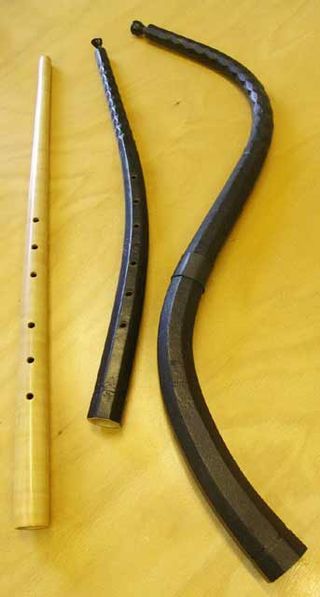
The cornett, cornetto, or zink is an early wind instrument that dates from the Medieval, Renaissance and Baroque periods, popular from 1500 to 1650.

A transposing instrument is a musical instrument for which music notation is not written at concert pitch. For example, playing a written middle C on a transposing instrument produces a pitch other than middle C; that sounding pitch identifies the interval of transposition when describing the instrument. Playing a written C on clarinet or soprano saxophone produces a concert B♭, so these are referred to as B♭ instruments. Providing transposed music for these instruments is a convention of musical notation. The instruments do not transpose the music; rather, their music is written at a transposed pitch. Where chords are indicated for improvisation they are also written in the appropriate transposed form.

The Mass in B minor, BWV 232, is an extended setting of the Mass ordinary by Johann Sebastian Bach. The composition was completed in 1749, the year before the composer's death, and was to a large extent based on earlier work, such as a Sanctus Bach had composed in 1724. Sections that were specifically composed to complete the Mass in the late 1740s include the "Et incarnatus est" part of the Credo.
In Western classical music, obbligato usually describes a musical line that is in some way indispensable in performance. Its opposite is the marking ad libitum. It can also be used, more specifically, to indicate that a passage of music was to be played exactly as written, or only by the specified instrument, without changes or omissions. The word is borrowed from Italian ; the spelling obligato is not acceptable in British English, but it is often used as an alternative spelling in the US. The word can stand on its own, in English, as a noun, or appear as a modifier in a noun phrase.
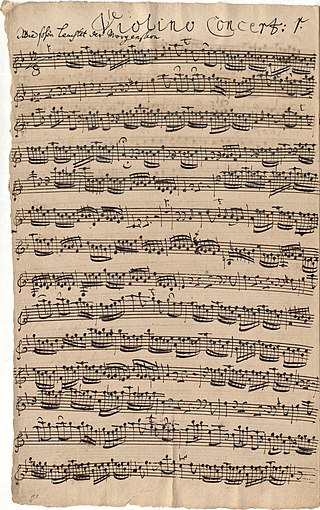
Wie schön leuchtet der Morgenstern, BWV 1, is a church cantata for Annunciation by Johann Sebastian Bach. In 1725, when the cantata was composed, the feast of the Annunciation coincided with Palm Sunday. Based on Philipp Nicolai's hymn "Wie schön leuchtet der Morgenstern" (1599), it is one of Bach's chorale cantatas. Bach composed it in his second year as Thomaskantor in Leipzig, where the Marian feast was the only occasion during Lent when music of this kind was permitted. The theme of the hymn suits both the Annunciation and Palm Sunday occasions, in a spirit of longing expectation of an arrival. As usual for Bach's chorale cantata cycle, the hymn was paraphrased by a contemporary poet who retained the hymn's first and last stanzas unchanged, but transformed the themes of the inner stanzas into a sequence of alternating recitatives and arias.

The oboe da caccia, also sometimes referred to as an oboe da silva, is a double reed woodwind instrument in the oboe family, pitched a fifth below the oboe and used primarily in the Baroque period of European classical music. It has a curved tube, and in the case of instruments by Eichentopf, a brass bell, unusual for an oboe.
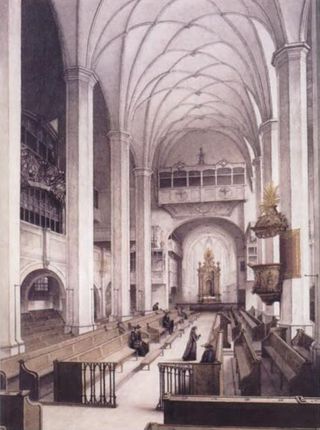
Halt im Gedächtnis Jesum Christ, BWV 67, is a church cantata by Johann Sebastian Bach. He composed it in Leipzig for Quasimodogeniti, the first Sunday after Easter, and first performed it on 16 April 1724.

The cantatas composed by Johann Sebastian Bach, known as Bach cantatas, are a body of work consisting of over 200 surviving independent works, and at least several dozen that are considered lost. As far as known, Bach's earliest cantatas date from 1707, the year he moved to Mühlhausen, although he may have begun composing them at his previous post in Arnstadt. Most of Bach's church cantatas date from his first years as Thomaskantor and director of church music in Leipzig, a position which he took up in 1723.

Herr, gehe nicht ins Gericht mit deinem Knecht, BWV 105 is a church cantata by Johann Sebastian Bach. He composed it in Leipzig for the ninth Sunday after Trinity and first performed it on 25 July 1723. The musicologist Alfred Dürr has described the cantata as one of "the most sublime descriptions of the soul in baroque and Christian art".

Jesus nahm zu sich die Zwölfe, BWV 22, is a church cantata by Johann Sebastian Bach composed for Quinquagesima, the last Sunday before Lent. Bach composed it as an audition piece for the position of Thomaskantor in Leipzig and first performed it there on 7 February 1723.

Johann Sebastian Bach composed the church cantata O Ewigkeit, du Donnerwort, BWV 20, in Leipzig for the first Sunday after Trinity and first performed it on 11 June 1724. Bach composed it when beginning his second year as Thomaskantor in Leipzig. It is the first cantata he composed for his second annual cycle which was planned to contain chorale cantatas, each based on a Lutheran hymn. The cantata is focused on Johann Rist's 1642 hymn "O Ewigkeit, du Donnerwort", with a chorale melody by Johann Schop. As usual for Bach's chorale cantatas to come in the cycle, selected hymn stanzas were retained while the others were paraphrased by a contemporary poet who transformed their ideas into a sequence of alternating recitatives and arias. For this cantata, the first stanza was used unchanged, and two more stanzas to conclude the cantata's two parts. The first part was performed before the sermon, the second part after the sermon. The first part is in seven movements, and the second part is in four movements.

Schauet doch und sehet, ob irgend ein Schmerz sei, BWV 46, is a church cantata by Johann Sebastian Bach. He composed it for the tenth Sunday after Trinity and it was first performed on 1 August 1723 in Leipzig.

Johann Sebastian Bach composed the church cantata Du sollt Gott, deinen Herren, lieben, BWV 77 in Leipzig for the thirteenth Sunday after Trinity and first performed it on 22 August 1723.

Johann Sebastian Bach composed the church cantata Ach! ich sehe, itzt, da ich zur Hochzeit gehe, BWV 162, in Weimar for the 20th Sunday after Trinity and first performed it in 1715 or 1716.
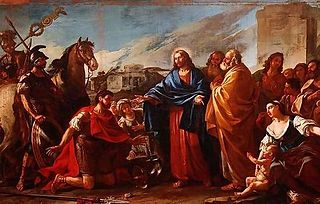
Johann Sebastian Bach composed the church cantata Ich glaube, lieber Herr, hilf meinem Unglauben, BWV 109, in Leipzig for the 21st Sunday after Trinity and first performed it on 17 October 1723.
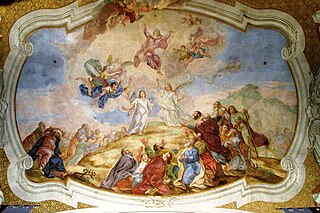
Auf Christi Himmelfahrt allein, BWV 128, is a church cantata by Johann Sebastian Bach. Bach composed it in Leipzig for the Feast of the Ascension and first performed it on 10 May 1725.
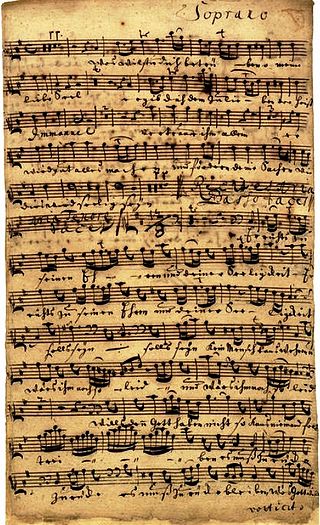
Johann Sebastian Bach composed the church cantata Was willst du dich betrüben, BWV 107 in Leipzig for the seventh Sunday after Trinity and first performed on 23 July 1724. The chorale cantata is based on the words of Johann Heermann's hymn in seven stanzas "Was willst du dich betrüben" (1630).

Johann Sebastian Bach composed the church cantata Ach, lieben Christen, seid getrost, BWV 114, in Leipzig for the 17th Sunday after Trinity and first performed it on 1 October 1724.
Lobe den Herrn, meine Seele, BWV 143, is an early cantata by Johann Sebastian Bach. He appears to have composed the cantata for New Year's Day, probably when he was in his 20s, but whether it was first performed in Mühlhausen or Weimar is not known: the date of composition is unclear. Bach's authorship has been doubted because the cantata has several unusual features; one of these is the scoring, it is the only Bach cantata to combine three corni da caccia with timpani.
References
- 1 2 3 Picon. "The Corno da tirarsi" (PDF). Retrieved 2017-12-14.
- ↑ "Bach's movements with corno da tirarsi". University of Alberta. Retrieved 4 June 2013.
- ↑ Diprose, Mike. "Programme notes March 2008". Barokensemble de swaen. Retrieved 4 June 2013.
- ↑ Randel, Don Michael, ed. (2003). The Harvard dictionary of music (4th ed.). Belknap Press of Harvard University Press. p. 215. ISBN 9780674011632.